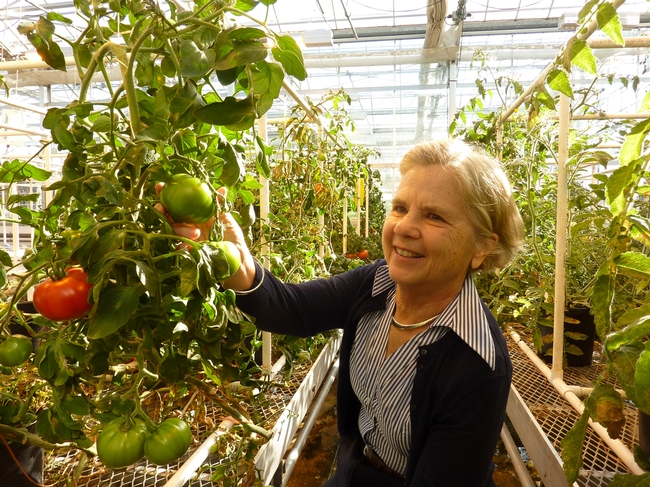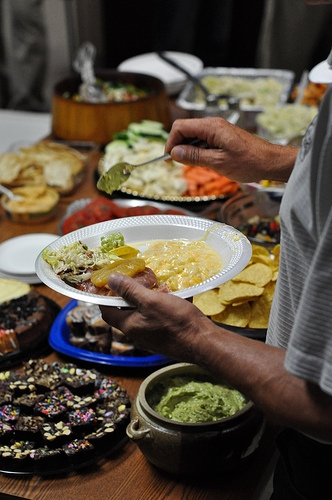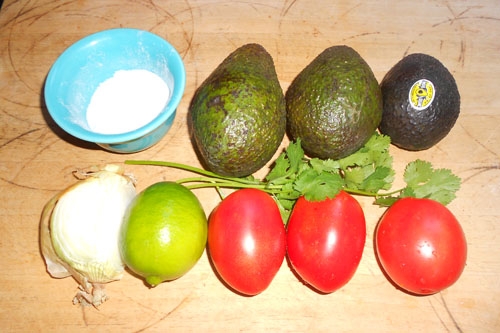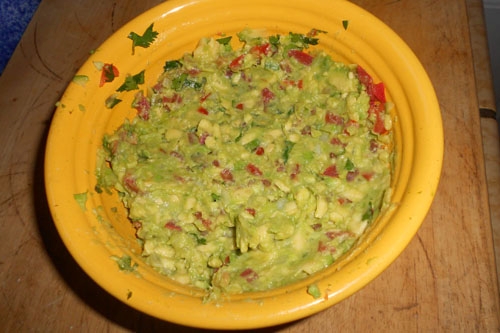UC Food Blog
Discovery could deliver vintage flavor to a tomato near you
People often complain about grocery store tomatoes, saying they’re too hard and don’t have the flavor we remember from the days of old. And we thought we knew why - because the millions of tons of tomatoes harvested in the United States and beyond have to be picked before they’re fully ripe and juicy in order to survive being shipped long distances. What’s more, many shoppers store their tomatoes in the fridge, which destroys both their flavor and texture.
But guess what? It’s not just how tomatoes are grown, harvested and stored that affect their flavor. A research team led by Ann Powell, a biochemist in the UC Davis Department of Plant Sciences, has discovered a gene mutation that diminishes a tomato’s flavor even if the fruit is picked ripe and stored well. The finding, which was reported in the June 29 issue of the journal Science, identifies a gene that was unknowingly bred out of modern cultivated tomatoes and plays a vital role in producing the sugars and aromas that make heirloom tomatoes so tasty.
The news is unexpected and encouraging, because now breeders have the genetic information they need to create modern varieties suited for large-scale harvest and shipping with all the flavor of more delicate heirloom varieties.
“Now that we know that some of the qualities that people value in heirloom tomatoes can be made available in other types of tomatoes, farmers can have access to more varieties of tomatoes that produce well and also have desirable color and flavor traits,” Powell said.
It takes awhile to breed a new tomato variety, so don’t expect to taste the results anytime soon. But Powell and her team’s discovery is a huge first step. Tomato lovers can also be grateful for C.M. Rick Tomato Genetics Resource Center at UC Davis, home to a vast collection of mutant and wild species of tomatoes which provides the genetic diversity scientists and breeders need to recapture the flavor of old.
You can read more about the study here.
You can access the Science article here.
You can learn more about the C.M. Rick Tomato Resource Center here.
Chicken salad recall put the spotlight on mysterious food pathogen, Listeria monocytogenes
The news this past week that nearly three tons of Trader Joe’s prepared barbeque chicken salad were recalled due to possible contamination by Listeria moncytogenes had me wondering anew about this mysterious foodborne pathogen. And today, seven tons of Garden Fresh prepared salads were also recalled.
I’ve spent precious minutes worrying about E. coli (ubiquitous, especially in poop) and Salmonella (the reason we must take care with raw eggs), but why doesn’t Listeria moncytogenes rank higher on my food-safety recognition meter?
A quick check of the U.S. Food and Drug Administration website showed that of 27 food recalls in July, 16 were related to Listeria monocytogenes. (One was linked to Staph bacteria, three to Salmonella and the rest to undeclared ingredients.)
Susan Algert, UC Cooperative Extension advisor in Santa Clara County, helped to fill me in. She is a nutrition, family and consumer sciences expert. Listeria monocytogenes is a ubiquitous soilborne bacteria found virtually everywhere.
The problem arises, Algert said, when the bacteria is spread by food handlers, farm equipment and food processing machines, then allowed to grow to levels that can cause illness.
“It can proliferate in the refrigerator if it’s not cold enough, under 40 °F,” Algert said, “and it will not be killed if food isn’t heated to over 140 °F.”
Safe food handling is key to preventing listeriosis, and all other foodborne illnesses, in people at greatest risk. This includes:
- Washing hands before preparing food.
- Thawing foods in the refrigerator — never at room temperature.
- Keeping foods cold (< 40 °F) or heating them thoroughly (> 140 °F).
- Disposing of perishable foods that have been left out for more than an hour.
“These measures are especially important at this time of year,” Algert said. “It’s warm. Dangerous bacteria in food will grow faster.”
(ANR has published guidelines for controlling Listeria monocytogenes in food packing operations.)
Algert noted that the symptoms of listeriosis can occur long after exposure, another reason why illnesses may not be linked to the bacteria.
“The incubation period is up to 70 days,” she said. “Many people get sick but don’t associate it with something they ate several weeks ago.”
While it was the chicken salad recall that hit the news, the recall actually involved all onions processed by Gill’s Onions of Oxnard, which supplies onions for processed salads and other foods. Other California products affected by the recall included Trader Joe’s salad dressings, butternut squash salad, and red quinoa and wheatberry salad. The Garden Fresh prepared salads also contained these onions.
The products were voluntarily recalled after FDA found Listeria monocytogenes in a random sample of diced yellow onions; the factory has been closed since July 17 pending an investigation. No illnesses have been linked to the possibly contaminated products.
“Gills Onions is committed to protecting public health and to executing this voluntary recall effectively and efficiently,” said Steve Gill, president of the company. “We are a multigenerational family business, and we work hard every day to earn the trust and confidence of customers and consumers who enjoy our high quality, healthy products.”
Anyone who has the recalled product should not consume it and destroy or discard it. Trader Joe’s said that it will provide full refunds.
Farm to fork, and all that's in between
* - Updated 8/6/2012
As the local food movement scales up and consumers demand information about where their food comes from, more grocers and institutions are seeking wholesale access to local produce. To make the connection between producers and retail sellers, distribution networks are taking on an increasingly important role in the local food system. More and more, farmers are becoming part of values-based supply chains and ‘food hubs’ to pool their product with that of other farmers and move food more easily to market and complete the chain from farm to fork (*).
New reports released by the UC Sustainable Agriculture Research and Education Program (SAREP) show that, while food hubs help close the gap in distribution efforts, farmers should invest carefully. UC SAREP has created a Farmer Toolkit for those interested in taking part in a food hub.
“We wanted to suggest some questions farmers should consider before getting involved with an enterprise,” said Gail Feenstra, academic coordinator at UC SAREP (*).
“When food hubs are working,” Feenstra said, “the farmer gets a higher price for their product, and everybody along the supply chain benefits. Consumers get the satisfaction of knowing where their food comes from, and the food is good quality” (*).
But the challenges of food hubs are steep. While food hubs often succeed at keeping the social and environmental values of their products front and center (that they are organic, local, or grown by family farmers, to name a few values), business plans for long-term success are not always part of the planning process (*).
Traditional distribution centers that have been the standard in produce distribution are incredibly well established compared to young food hubs. In researching existing distribution networks, “we found that there are really long-standing partnerships amongst distributors,” says Feenstra. “They go back decades and generations.”
For farmers looking to keep their social and environmental values embedded in their products, abandoning traditional distribution networks may not be the way to succeed. Rather, “creative partnerships between conventional players and more alternative folks may be a better model. In cases where you can create cooperative of growers in which they own the process and they’ve got good management, it’s a slow build up, it can’t happen overnight. But they can succeed,” Feenstra said.
The farmer toolkit is meant to give farmers a better sense of how to make that success happen and how to bring the value of sustainably produced food into the supply chain.
The farmer toolkit and more information on values-based supply chains can be found at the UC SAREP Web site.
Farmer Toolkit
Foodborne illnesses and the 100K Genome Project
An ambitious effort to sequence the genomes of 100,000 infectious microorganisms and speed diagnosis of foodborne illnesses has been launched by the University of California, Davis, Agilent Technologies, and the U.S. Food and Drug Administration.
Bart Weimer, professor in the UC Davis School of Veterinary Medicine, serves as director of the 100K Genome Project and co-director of the recently established BGI@UC Davis facility, where the sequencing will be done. Other collaborators include the U.S. Centers for Disease Control and Prevention and the U.S. Department of Agriculture.
The new five-year microbial pathogen project focuses on making the food supply safer for consumers. The group will build a free, public database including sequence information for each pathogen's genome — the complete collection of its hereditary information. The database will contain the genomes of important foodborne pathogens including Salmonella, Listeria, and E. coli, as well as the most common foodborne and waterborne viruses that sicken people and animals.
The project will provide a roadmap for developing tests to identify pathogens and help trace their origins more quickly. The new genome database also will enable scientists to make discoveries that can be used to develop new methods for controlling disease-causing bacteria in the food chain.
"This landmark project will revolutionize our basic understanding of these disease-causing microorganisms," said Harris Lewin, vice chancellor for research at UC Davis.
The sequencing project is critically important for tackling the continuing outbreaks of often-deadly foodborne diseases around the world. In the United States alone, foodborne diseases annually sicken 48 million people and kill 3,000, according to the CDC.
"The lack of information about food-related bacterial genomes is hindering the research community's ability to improve the safety and security of the world food supply," Weimer said. "The data provided by the 100K Genome Project will make diagnostic tests quicker, more reliable, more accurate and more cost-effective."
"We see this project as a way to improve quality of life for a great many people, while minimizing a major business risk for food producers and distributors," said Mike McMullen, president of Agilent’s Chemical Analysis Group.
A consumer-focused article about the project is available on the FDA website.
(This article was condensed from a UC Davis news release. Read the full press release and watch a video of Bart Weimer giving an overview of the project.)
Adding variety: avocados and guacamole
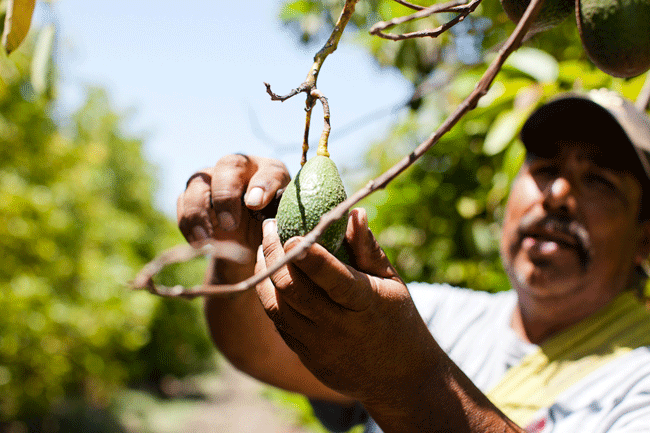
I have limited cooking skills, so I’m lucky that my wife is a great cook and an even better baker – lemon bars, anyone?
But there’s one dish she prefers that I prepare: guacamole. I was thinking about this when I was reviewing our recent photo shoot at UC ANR’s South Coast Research and Extension Center in Irvine, which included images of strawberries, citrus and avocados.
“Our whole goal is to make the industry in California more sustainable,” said UC Cooperative Extension specialist Mary Lu Arpaia, in the Department of Botany and Plant Sciences at UC Riverside.
Arpaia leads UC’s efforts to develop new avocado varieties. The dominant variety, Hass, started in 1926 in Southern California and has become so common globally that it could become generic, Arpaia said.
“My belief is the way we’re going to differentiate ourselves as a California industry and survive is by breeding something unique,” Arpaia said.
UC Riverside has developed several avocado varieties, signing a license agreement last year for its latest release, GEM. The great-granddaughter of the Hass avocado, GEM shares Hass’ desired characteristics such as a creamy, nutty flesh while offering growers additional benefits such as being a smaller tree that typically is more productive, Arpaia said.
Arpaia is evaluating more varieties. The next potential release is likely two to three years away, she said.
Meanwhile, Arpaia also is collaborating with the U.S. Department of Agriculture to improve the postharvest quality of avocados – how packing houses and distribution centers should handle the fruit, for how long and at what temperature.
“People definitely like fruit that is creamy, smooth, nutty and buttery. They like fruit that has a pleasant aftertaste,” said Arpaia, who conducts monthly avocado tasting panels at UC Riverside.
Packed with nearly 20 nutrients including potassium, avocados are an appetizing addition to salads and sandwiches. Arpaia likes them sliced, eaten alone, in a salad or on a warm corn tortilla. Some like them sweet in cheesecake or milkshakes. Of course, they’re best known as the base ingredient in guacamole.
I keep my guacamole simple: avocados (three), white onion (one-third), Roma tomatoes (three), lime (one), cilantro and salt. I start by scooping out the avocado pulp, slicing it into medium chunks and putting it in a bowl, mixing in lime juice. Then I dice the onion and tomatoes (seeded) into fine pieces and toss them in the bowl, followed by chopped cilantro. Next, I mash it up with a spoon, sprinkling on some salt and more lime juice. Test it and then serve.
For a spicier version, add garlic, jalapeños or serranos. The possibilities are plentiful. Just make sure you start with ripe avocados. What’s your favorite guacamole recipe?


